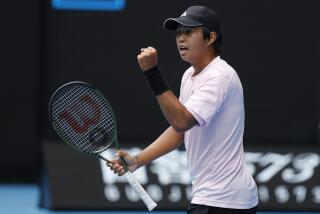This Guy Isn’t an Average Joe : Tennis: Todd Martin thinks of himself as being ordinary. On the court, though, he has become something special.
- Share via
INDIAN WELLS — To hear Todd Martin tell it, his rise into the top 10 of the ATP Tour rankings is a tribute to clean living, good parenting, Midwestern values and an old-fashioned work ethic.
If that sounds a bit boring, Martin couldn’t care less.
He proudly described himself as “an All-American kid” last month at the Australian Open, where he was a surprise finalist, and is not the least bit apologetic about his ordinariness.
“My parents are pretty clean-cut and conservative, and I think I’ve modeled myself after them my whole life,” he said. “And I think I’ve turned out to be your fairly average Joe off the street.”
With racket in hand, however, he stands apart.
Martin, 23, was selected as most-improved male professional of 1993 by Tennis magazine after improving his ranking from No. 87 to No. 13, beating five top-10 players and reaching the Wimbledon quarterfinals last year.
He continued his climb in Australia, moving into the top 10 despite losing to Pete Sampras in the final, and won his second pro title two weeks ago at Memphis, where his career first took flight a year ago.
“I always believed in him,” said Sampras, who was pushed to five sets by Martin in the third round of the 1992 U.S. Open. “This doesn’t surprise me at all.”
Next month, Martin will make his Davis Cup debut, playing singles when the United States meets India in a first-round match at New Delhi.
“Fortunately enough for me, I’m enjoying some success at a game I took up in a park for the fun of it and to be able to spend a little extra time with my parents,” said Martin, who is ranked ninth entering the Newsweek Champions Cup, which runs Monday through next Sunday at Hyatt Grand Champions.
Martin’s, though, was not an overnight success story.
Unlike his most celebrated contemporaries--Sampras, Jim Courier, Michael Chang and Andre Agassi--the 6-foot-6 Martin went to college, studying linguistics and playing two seasons of tennis at Northwestern.
And after turning pro in 1990, he concentrated on ironing out the kinks in his game rather than boosting his ranking.
“That means not going to every nook and cranny of the world to play in a satellite tournament to get points,” said Martin, who gradually improved his ranking from No. 269 in 1990 to No. 133 in ’91 to No. 87 in ’92. “I decided to do what I could to improve on what everybody thought I needed to improve on, and what I felt like I needed to improve on.
“And that’s what I say has provided me with the chance to play as well as I have in the past year.”
Martin said he has always been a late bloomer.
“I wasn’t the most gifted athlete in the juniors, but I think I knew the game pretty well and I had a good coach and I made a lot of gradual improvements,” said Martin, who gave up basketball in high school at Lansing, Mich., so he could concentrate on landing a college scholarship in tennis. “And then, the same thing in college.”
Martin started his ascent last year in Memphis, where he defeated Agassi and Chang before losing to Courier in his first tour final.
“Those were my first big wins, but the big thing was, I won three matches to get there. That was something that wasn’t happening very often for me, so I was already excited.
“And when I got by those two guys and played well against Jim in the final, that sort of ensured me that it wasn’t a fluke. I played well seven days in a row, and that’s a pretty encouraging feeling.”
Martin reached the final in four more tournaments last year, winning his first pro title on clay at Coral Springs, Fla., and posted victories over Stefan Edberg, Boris Becker and Goran Ivanisevic.
In Australia last month, he defeated Edberg again, winning three tiebreakers in a 3-6, 7-6, 7-6, 7-6 semifinal victory.
A baseliner as a younger player, Martin has developed a more attacking style during the past year, combining a net-charging approach with a two-handed backhand.
“I’ve developed a serve that has enabled me to get to the net more and more,” he said. “I’m getting more and more aggressive every year now, and I think the more aggressive I am, the better I’m going to get.”
More to Read
Go beyond the scoreboard
Get the latest on L.A.'s teams in the daily Sports Report newsletter.
You may occasionally receive promotional content from the Los Angeles Times.










